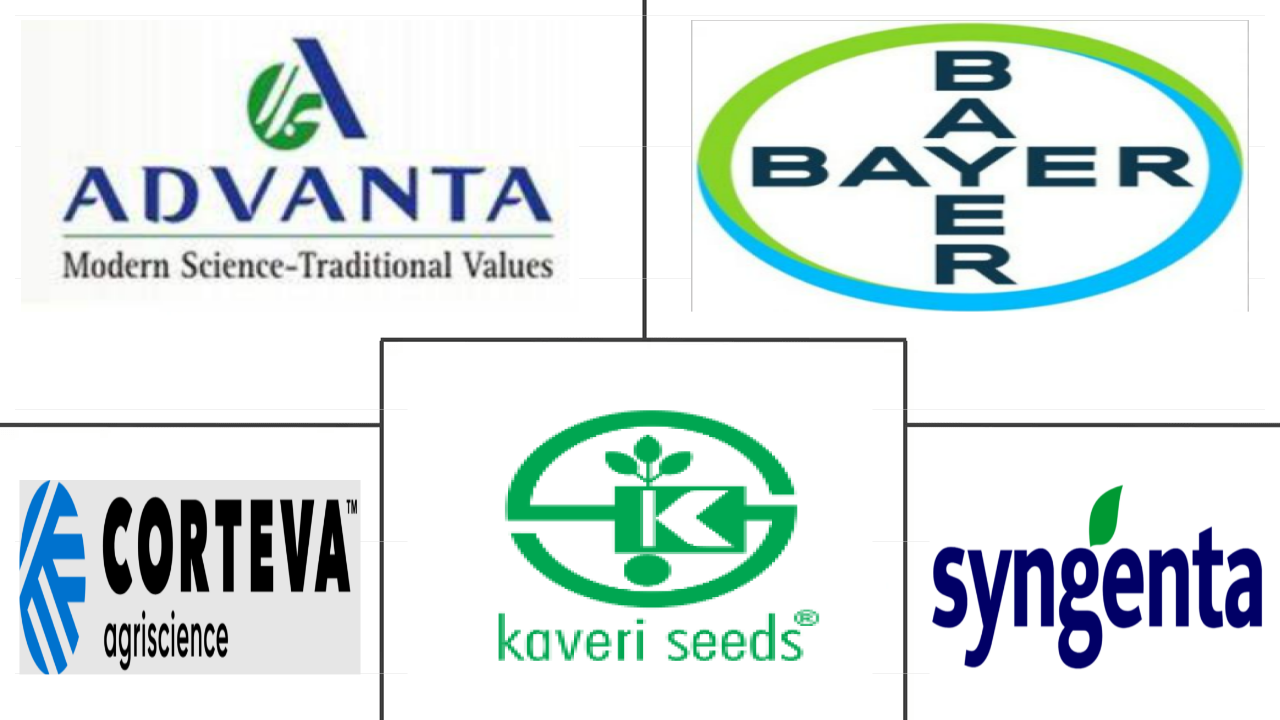Market Size of india seed Industry
|
|
Study Period | 2017 - 2030 |
|
|
Market Size (2024) | USD 3.61 Billion |
|
|
Market Size (2030) | USD 5.01 Billion |
|
|
Largest Share by Breeding Technology | Hybrids |
|
|
CAGR (2024 - 2030) | 5.58 % |
|
|
Fastest Growing by Breeding Technology | Hybrids |
Major Players |
||

|
||
|
*Disclaimer: Major Players sorted in no particular order |
India Seed Market Analysis
The India Seed Market size is estimated at 3.61 billion USD in 2024, and is expected to reach 5.01 billion USD by 2030, growing at a CAGR of 5.58% during the forecast period (2024-2030).
3.61 Billion
Market Size in 2024 (USD)
5.01 Billion
Market Size in 2030 (USD)
7.39 %
CAGR (2017-2023)
5.58 %
CAGR (2024-2030)
Largest Market by Crop Family
33.39 %
value share, Grains & Cereals, 2023
Grains & cereals is the largest segment as India is the leading producer of grains, rice is a staple food for South India, and wheat is most consumed in North India.
Largest Market by Breeding Technology
70.02 %
value share, Hybrids, 2023
There is an increase in the demand for hybrid seeds due to their higher productivity, wider adaptability, and a high degree of resistance to biotic and abiotic stresses.
Fastest-growing Market by Crop Family
6.73 %
Projected CAGR, Solanaceae, 2024-2030
India is the largest producer and consumer of tomatoes, chilies, and eggplants. As a result of increased cultivation, the demand for Solanaceae seeds has grown significantly.
Fastest-growing Market by Breeding Technology
5.71 %
Projected CAGR, Hybrids, 2024-2030
These seeds are widely used to cultivate vegetables, fiber crops, and cereal crops in the country. With growing domestic demand, the usage of hybrids is estimated to increase significantly.
Leading Market Player
8.41 %
market share, Bayer AG, 2022

The company has made extensive product innovations and effective partnerships. It introduced new high-yielding hybrid varieties, including corn seeds, in India.
Hybrids dominate the seed market in the country with the increase in the concerns for higher yield
- In India, hybrids dominated over open-pollinated varieties, accounting for USD 2.3 billion in 2022. Farmers are adopting and using more hybrid seeds, considering the pest-resistant properties of these seeds that reduce the losses and cost of production.
- The per capita availability of arable land decreasing to 0.11 ha in 2020 from 0.12 ha in 2016 is considered a driver for India's commercial seed industry.
- In 2022, hybrid seed usage increased in the country by adopting transgenic cotton hybrids, single-cross corn hybrids, oil-rich oilseed hybrids, and hybrid vegetables. This increased demand for hybrid seeds has boosted the market for commercial seeds. This trend has encouraged farmers to shift their focus from conventional seed sources to packaged seeds that promise better yields.
- In commercial seed cultivation acreage in 2022, hybrids alone accounted for 80.6% of the area, whereas OPVs accounted for 19.4% in India. Therefore, the seed market is estimated to increase as hybrid usage grows in the country.
- The major breeding techniques include selecting plants based on natural variants, hybridizing, and choosing specific genes or marker profiles using molecular tools. The main objective of these techniques is the selection of better plant types among variants in terms of yield, quality, and pest resistance.
- The scenario post-adoption of hybrids and improved OPVs has resulted in many advantages, such as yield improvement, ensuring higher prices, and availability of seeds at an affordable price. These factors will drive the growth of the Indian seed market in the forecast period.
India Seed Industry Segmentation
Hybrids, Open Pollinated Varieties & Hybrid Derivatives are covered as segments by Breeding Technology. Open Field, Protected Cultivation are covered as segments by Cultivation Mechanism. Row Crops, Vegetables are covered as segments by Crop Type. Bihar, Gujarat, Haryana, Karnataka, Madhya Pradesh, Maharashtra, Rajasthan, Telangana, Uttar Pradesh, West Bengal are covered as segments by State.
- In India, hybrids dominated over open-pollinated varieties, accounting for USD 2.3 billion in 2022. Farmers are adopting and using more hybrid seeds, considering the pest-resistant properties of these seeds that reduce the losses and cost of production.
- The per capita availability of arable land decreasing to 0.11 ha in 2020 from 0.12 ha in 2016 is considered a driver for India's commercial seed industry.
- In 2022, hybrid seed usage increased in the country by adopting transgenic cotton hybrids, single-cross corn hybrids, oil-rich oilseed hybrids, and hybrid vegetables. This increased demand for hybrid seeds has boosted the market for commercial seeds. This trend has encouraged farmers to shift their focus from conventional seed sources to packaged seeds that promise better yields.
- In commercial seed cultivation acreage in 2022, hybrids alone accounted for 80.6% of the area, whereas OPVs accounted for 19.4% in India. Therefore, the seed market is estimated to increase as hybrid usage grows in the country.
- The major breeding techniques include selecting plants based on natural variants, hybridizing, and choosing specific genes or marker profiles using molecular tools. The main objective of these techniques is the selection of better plant types among variants in terms of yield, quality, and pest resistance.
- The scenario post-adoption of hybrids and improved OPVs has resulted in many advantages, such as yield improvement, ensuring higher prices, and availability of seeds at an affordable price. These factors will drive the growth of the Indian seed market in the forecast period.
| Breeding Technology | ||||||
| ||||||
| Open Pollinated Varieties & Hybrid Derivatives |
| Cultivation Mechanism | |
| Open Field | |
| Protected Cultivation |
| Crop Type | |||||||||||||||||||||||||||||||||
| |||||||||||||||||||||||||||||||||
|
| State | |
| Bihar | |
| Gujarat | |
| Haryana | |
| Karnataka | |
| Madhya Pradesh | |
| Maharashtra | |
| Rajasthan | |
| Telangana | |
| Uttar Pradesh | |
| West Bengal | |
| Other States |
India Seed Market Size Summary
The Indian seed market is experiencing significant growth, driven by the increasing adoption of hybrid seeds over traditional open-pollinated varieties. This shift is largely due to the pest-resistant properties of hybrid seeds, which help reduce production losses and costs. The decreasing per capita availability of arable land is also a contributing factor, prompting farmers to seek more efficient seed solutions. The market is further bolstered by the adoption of advanced breeding techniques and modern agricultural technologies, which enhance yield, quality, and pest resistance. The diverse agro-climatic zones in India support the cultivation of various row crops, with rice and wheat being the most prominent due to their stable demand and government support. This diversification and technological advancement are expected to drive the seed market's expansion in the coming years.
The market landscape is characterized by a fragmented structure, with major players like Advanta Seeds - UPL, Bayer AG, Corteva Agriscience, Kaveri Seeds, and Syngenta Group holding significant shares. These companies are actively involved in developing high-quality seed varieties with traits such as disease resistance, increased shelf life, and adaptability to adverse weather conditions. The demand for high-value crops, such as cabbage and onion, is on the rise, both domestically and internationally, further fueling market growth. Initiatives like BASF's expansion of its soybean seed portfolio and collaborative projects addressing social issues in the seed sector highlight the dynamic nature of the industry. As the market continues to evolve, innovations in seed technology and strategic partnerships are likely to play a crucial role in shaping its future trajectory.
India Seed Market Size - Table of Contents
-
1. MARKET SEGMENTATION (includes market size in Value in USD, Forecasts up to 2030 and analysis of growth prospects)
-
1.1 Breeding Technology
-
1.1.1 Hybrids
-
1.1.1.1 Non-Transgenic Hybrids
-
1.1.1.2 Transgenic Hybrids
-
1.1.1.2.1 Insect Resistant Hybrids
-
-
-
1.1.2 Open Pollinated Varieties & Hybrid Derivatives
-
-
1.2 Cultivation Mechanism
-
1.2.1 Open Field
-
1.2.2 Protected Cultivation
-
-
1.3 Crop Type
-
1.3.1 Row Crops
-
1.3.1.1 Fiber Crops
-
1.3.1.1.1 Cotton
-
1.3.1.1.2 Other Fiber Crops
-
-
1.3.1.2 Forage Crops
-
1.3.1.2.1 Alfalfa
-
1.3.1.2.2 Forage Corn
-
1.3.1.2.3 Forage Sorghum
-
1.3.1.2.4 Other Forage Crops
-
-
1.3.1.3 Grains & Cereals
-
1.3.1.3.1 Corn
-
1.3.1.3.2 Rice
-
1.3.1.3.3 Sorghum
-
1.3.1.3.4 Wheat
-
1.3.1.3.5 Other Grains & Cereals
-
-
1.3.1.4 Oilseeds
-
1.3.1.4.1 Canola, Rapeseed & Mustard
-
1.3.1.4.2 Soybean
-
1.3.1.4.3 Sunflower
-
1.3.1.4.4 Other Oilseeds
-
-
1.3.1.5 Pulses
-
-
1.3.2 Vegetables
-
1.3.2.1 Brassicas
-
1.3.2.1.1 Cabbage
-
1.3.2.1.2 Carrot
-
1.3.2.1.3 Cauliflower & Broccoli
-
1.3.2.1.4 Other Brassicas
-
-
1.3.2.2 Cucurbits
-
1.3.2.2.1 Cucumber & Gherkin
-
1.3.2.2.2 Pumpkin & Squash
-
1.3.2.2.3 Other Cucurbits
-
-
1.3.2.3 Roots & Bulbs
-
1.3.2.3.1 Garlic
-
1.3.2.3.2 Onion
-
1.3.2.3.3 Potato
-
1.3.2.3.4 Other Roots & Bulbs
-
-
1.3.2.4 Solanaceae
-
1.3.2.4.1 Chilli
-
1.3.2.4.2 Eggplant
-
1.3.2.4.3 Tomato
-
1.3.2.4.4 Other Solanaceae
-
-
1.3.2.5 Unclassified Vegetables
-
1.3.2.5.1 Asparagus
-
1.3.2.5.2 Lettuce
-
1.3.2.5.3 Okra
-
1.3.2.5.4 Peas
-
1.3.2.5.5 Spinach
-
1.3.2.5.6 Other Unclassified Vegetables
-
-
-
-
1.4 State
-
1.4.1 Bihar
-
1.4.2 Gujarat
-
1.4.3 Haryana
-
1.4.4 Karnataka
-
1.4.5 Madhya Pradesh
-
1.4.6 Maharashtra
-
1.4.7 Rajasthan
-
1.4.8 Telangana
-
1.4.9 Uttar Pradesh
-
1.4.10 West Bengal
-
1.4.11 Other States
-
-
India Seed Market Size FAQs
How big is the India Seed Market?
The India Seed Market size is expected to reach USD 3.61 billion in 2024 and grow at a CAGR of 5.58% to reach USD 5.01 billion by 2030.
What is the current India Seed Market size?
In 2024, the India Seed Market size is expected to reach USD 3.61 billion.

